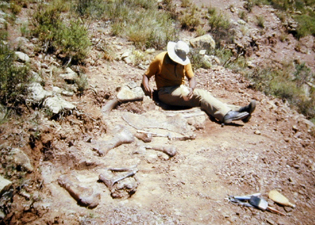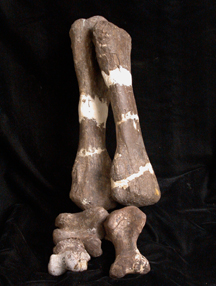
Geotimes Home | AGI Home | Information Services | Geoscience Education | Public Policy | Programs | Publications | Careers

 More than 20
years after unearthing a 215 million-year-old skeleton, paleontologists are realizing
the value of their find. A researcher at the University of Witwatersrand in Johannesburg,
South Africa, has discovered that the bones belong to a previously unseen dinosaur
— becoming the oldest known species among the giant, four-legged sauropods.
More than 20
years after unearthing a 215 million-year-old skeleton, paleontologists are realizing
the value of their find. A researcher at the University of Witwatersrand in Johannesburg,
South Africa, has discovered that the bones belong to a previously unseen dinosaur
— becoming the oldest known species among the giant, four-legged sauropods. Yates,
who specializes in vertebrate evolution, has named the dinosaur Antetonitrus
ingenipes, as described in the July 3 Proceedings of the Royal Society:
Biological Sciences. The genus name Antetonitrus means “before
the thunder” — a reference to the dinosaur’s descendant Brontosaurus,
or “thunder lizard”; and the species name ingenipes means “massive
paw.”
Yates,
who specializes in vertebrate evolution, has named the dinosaur Antetonitrus
ingenipes, as described in the July 3 Proceedings of the Royal Society:
Biological Sciences. The genus name Antetonitrus means “before
the thunder” — a reference to the dinosaur’s descendant Brontosaurus,
or “thunder lizard”; and the species name ingenipes means “massive
paw.” |
Geotimes Home | AGI Home | Information Services | Geoscience Education | Public Policy | Programs | Publications | Careers |